Yi Hu
RecGPT Technical Report
Jul 30, 2025



Abstract:Recommender systems are among the most impactful applications of artificial intelligence, serving as critical infrastructure connecting users, merchants, and platforms. However, most current industrial systems remain heavily reliant on historical co-occurrence patterns and log-fitting objectives, i.e., optimizing for past user interactions without explicitly modeling user intent. This log-fitting approach often leads to overfitting to narrow historical preferences, failing to capture users' evolving and latent interests. As a result, it reinforces filter bubbles and long-tail phenomena, ultimately harming user experience and threatening the sustainability of the whole recommendation ecosystem. To address these challenges, we rethink the overall design paradigm of recommender systems and propose RecGPT, a next-generation framework that places user intent at the center of the recommendation pipeline. By integrating large language models (LLMs) into key stages of user interest mining, item retrieval, and explanation generation, RecGPT transforms log-fitting recommendation into an intent-centric process. To effectively align general-purpose LLMs to the above domain-specific recommendation tasks at scale, RecGPT incorporates a multi-stage training paradigm, which integrates reasoning-enhanced pre-alignment and self-training evolution, guided by a Human-LLM cooperative judge system. Currently, RecGPT has been fully deployed on the Taobao App. Online experiments demonstrate that RecGPT achieves consistent performance gains across stakeholders: users benefit from increased content diversity and satisfaction, merchants and the platform gain greater exposure and conversions. These comprehensive improvement results across all stakeholders validates that LLM-driven, intent-centric design can foster a more sustainable and mutually beneficial recommendation ecosystem.
EXAONE Path 2.0: Pathology Foundation Model with End-to-End Supervision
Jul 09, 2025Abstract:In digital pathology, whole-slide images (WSIs) are often difficult to handle due to their gigapixel scale, so most approaches train patch encoders via self-supervised learning (SSL) and then aggregate the patch-level embeddings via multiple instance learning (MIL) or slide encoders for downstream tasks. However, patch-level SSL may overlook complex domain-specific features that are essential for biomarker prediction, such as mutation status and molecular characteristics, as SSL methods rely only on basic augmentations selected for natural image domains on small patch-level area. Moreover, SSL methods remain less data efficient than fully supervised approaches, requiring extensive computational resources and datasets to achieve competitive performance. To address these limitations, we present EXAONE Path 2.0, a pathology foundation model that learns patch-level representations under direct slide-level supervision. Using only 37k WSIs for training, EXAONE Path 2.0 achieves state-of-the-art average performance across 10 biomarker prediction tasks, demonstrating remarkable data efficiency.
From Local Patterns to Global Understanding: Cross-Stock Trend Integration for Enhanced Predictive Modeling
May 22, 2025Abstract:Stock price prediction is a critical area of financial forecasting, traditionally approached by training models using the historical price data of individual stocks. While these models effectively capture single-stock patterns, they fail to leverage potential correlations among stock trends, which could improve predictive performance. Current single-stock learning methods are thus limited in their ability to provide a broader understanding of price dynamics across multiple stocks. To address this, we propose a novel method that merges local patterns into a global understanding through cross-stock pattern integration. Our strategy is inspired by Federated Learning (FL), a paradigm designed for decentralized model training. FL enables collaborative learning across distributed datasets without sharing raw data, facilitating the aggregation of global insights while preserving data privacy. In our adaptation, we train models on individual stock data and iteratively merge them to create a unified global model. This global model is subsequently fine-tuned on specific stock data to retain local relevance. The proposed strategy enables parallel training of individual stock models, facilitating efficient utilization of computational resources and reducing overall training time. We conducted extensive experiments to evaluate the proposed method, demonstrating that it outperforms benchmark models and enhances the predictive capabilities of state-of-the-art approaches. Our results highlight the efficacy of Cross-Stock Trend Integration (CSTI) in advancing stock price prediction, offering a robust alternative to traditional single-stock learning methodologies.
PHYBench: Holistic Evaluation of Physical Perception and Reasoning in Large Language Models
Apr 22, 2025



Abstract:We introduce PHYBench, a novel, high-quality benchmark designed for evaluating reasoning capabilities of large language models (LLMs) in physical contexts. PHYBench consists of 500 meticulously curated physics problems based on real-world physical scenarios, designed to assess the ability of models to understand and reason about realistic physical processes. Covering mechanics, electromagnetism, thermodynamics, optics, modern physics, and advanced physics, the benchmark spans difficulty levels from high school exercises to undergraduate problems and Physics Olympiad challenges. Additionally, we propose the Expression Edit Distance (EED) Score, a novel evaluation metric based on the edit distance between mathematical expressions, which effectively captures differences in model reasoning processes and results beyond traditional binary scoring methods. We evaluate various LLMs on PHYBench and compare their performance with human experts. Our results reveal that even state-of-the-art reasoning models significantly lag behind human experts, highlighting their limitations and the need for improvement in complex physical reasoning scenarios. Our benchmark results and dataset are publicly available at https://phybench-official.github.io/phybench-demo/.
Tin-Tin: Towards Tiny Learning on Tiny Devices with Integer-based Neural Network Training
Apr 13, 2025Abstract:Recent advancements in machine learning (ML) have enabled its deployment on resource-constrained edge devices, fostering innovative applications such as intelligent environmental sensing. However, these devices, particularly microcontrollers (MCUs), face substantial challenges due to limited memory, computing capabilities, and the absence of dedicated floating-point units (FPUs). These constraints hinder the deployment of complex ML models, especially those requiring lifelong learning capabilities. To address these challenges, we propose Tin-Tin, an integer-based on-device training framework designed specifically for low-power MCUs. Tin-Tin introduces novel integer rescaling techniques to efficiently manage dynamic ranges and facilitate efficient weight updates using integer data types. Unlike existing methods optimized for devices with FPUs, GPUs, or FPGAs, Tin-Tin addresses the unique demands of tiny MCUs, prioritizing energy efficiency and optimized memory utilization. We validate the effectiveness of Tin-Tin through end-to-end application examples on real-world tiny devices, demonstrating its potential to support energy-efficient and sustainable ML applications on edge platforms.
Training Large Language Models to be Better Rule Followers
Feb 17, 2025Abstract:Large language models (LLMs) have shown impressive performance across a wide range of tasks. However, they often exhibit unexpected failures in seemingly straightforward tasks, suggesting a reliance on case-based reasoning rather than rule-based reasoning. While the vast training corpus of LLMs contains numerous textual "rules", current training methods fail to leverage these rules effectively. Crucially, the relationships between these "rules" and their corresponding "instances" are not explicitly modeled. As a result, while LLMs can often recall rules with ease, they fail to apply these rules strictly and consistently in relevant reasoning scenarios. In this paper, we investigate the rule-following capabilities of LLMs and propose Meta Rule-Following Fine-Tuning (Meta-RFFT) to enhance the cross-task transferability of rule-following abilities. We first construct a dataset of 88 tasks requiring following rules, encompassing diverse reasoning domains. We demonstrate through extensive experiments that models trained on large-scale rule-following tasks are better rule followers, outperforming the baselines in both downstream fine-tuning and few-shot prompting scenarios. This highlights the cross-task transferability of models with the aid of Meta-RFFT. Furthermore, we examine the influence of factors such as dataset size, rule formulation, and in-context learning.
RedStar: Does Scaling Long-CoT Data Unlock Better Slow-Reasoning Systems?
Jan 20, 2025Abstract:Can scaling transform reasoning? In this work, we explore the untapped potential of scaling Long Chain-of-Thought (Long-CoT) data to 1000k samples, pioneering the development of a slow-thinking model, RedStar. Through extensive experiments with various LLMs and different sizes, we uncover the ingredients for specialization and scale for Long-CoT training. Surprisingly, even smaller models show significant performance gains with limited data, revealing the sample efficiency of Long-CoT and the critical role of sample difficulty in the learning process. Our findings demonstrate that Long-CoT reasoning can be effectively triggered with just a few thousand examples, while larger models achieve unparalleled improvements. We also introduce reinforcement learning (RL)-scale training as a promising direction for advancing slow-thinking systems. RedStar shines across domains: on the MATH-Hard benchmark, RedStar-code-math boosts performance from 66.2\% to 81.6\%, and on the USA Math Olympiad (AIME), it solves 46.7\% of problems using only 21k mixed-code-math datasets. In multimodal tasks like GeoQA and MathVista-GEO, RedStar-Geo achieves competitive results with minimal Long-CoT data, outperforming other slow-thinking systems like QvQ-Preview. Compared to QwQ, RedStar strikes the perfect balance between reasoning and generalizability. Our work highlights that, with careful tuning, scaling Long-CoT can unlock extraordinary reasoning capabilities-even with limited dataset and set a new standard for slow-thinking models across diverse challenges. Our data and models are released at https://huggingface.co/RedStar-Reasoning.
Machine Learning Analysis of Anomalous Diffusion
Dec 02, 2024



Abstract:The rapid advancements in machine learning have made its application to anomalous diffusion analysis both essential and inevitable. This review systematically introduces the integration of machine learning techniques for enhanced analysis of anomalous diffusion, focusing on two pivotal aspects: single trajectory characterization via machine learning and representation learning of anomalous diffusion. We extensively compare various machine learning methods, including both classical machine learning and deep learning, used for the inference of diffusion parameters and trajectory segmentation. Additionally, platforms such as the Anomalous Diffusion Challenge that serve as benchmarks for evaluating these methods are highlighted. On the other hand, we outline three primary strategies for representing anomalous diffusion: the combination of predefined features, the feature vector from the penultimate layer of neural network, and the latent representation from the autoencoder, analyzing their applicability across various scenarios. This investigation paves the way for future research, offering valuable perspectives that can further enrich the study of anomalous diffusion and advance the application of artificial intelligence in statistical physics and biophysics.
Number Cookbook: Number Understanding of Language Models and How to Improve It
Nov 06, 2024
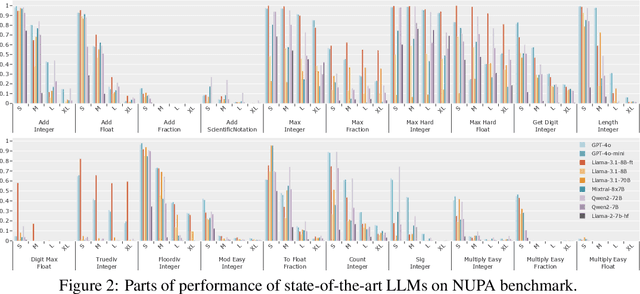
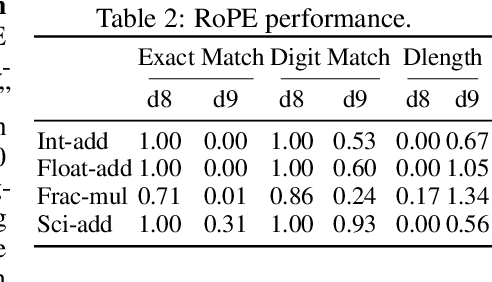
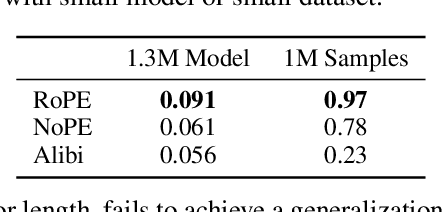
Abstract:Large language models (LLMs) can solve an increasing number of complex reasoning tasks while making surprising mistakes in basic numerical understanding and processing (such as 9.11 > 9.9). The latter ability is essential for tackling complex arithmetic and mathematical problems and serves as a foundation for most reasoning tasks, but previous work paid little attention to it or only discussed several restricted tasks (like integer addition). In this paper, we comprehensively investigate the numerical understanding and processing ability (NUPA) of LLMs. Firstly, we introduce a benchmark covering four common numerical representations and 17 distinct numerical tasks in four major categories, resulting in 41 meaningful combinations in total. These tasks are derived from primary and secondary education curricula, encompassing nearly all everyday numerical understanding and processing scenarios, and the rules of these tasks are very simple and clear. Through the benchmark, we find that current LLMs fail frequently in many of the tasks. To study the problem, we train small models with existing and potential techniques for enhancing NUPA (such as special tokenizers, PEs, and number formats), comprehensively evaluating their effectiveness using our testbed. We also finetune practical-scale LLMs on our proposed NUPA tasks and find that 1) naive finetuning can improve NUPA a lot on many but not all tasks, and 2) surprisingly, techniques designed to enhance NUPA prove ineffective for finetuning pretrained models. We further explore the impact of chain-of-thought techniques on NUPA. Our work takes a preliminary step towards understanding and improving NUPA of LLMs. Our benchmark and code are released at https://github.com/GraphPKU/number_cookbook.
Enhancing Whole Slide Pathology Foundation Models through Stain Normalization
Aug 05, 2024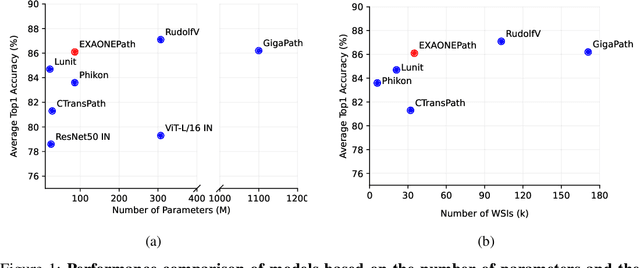

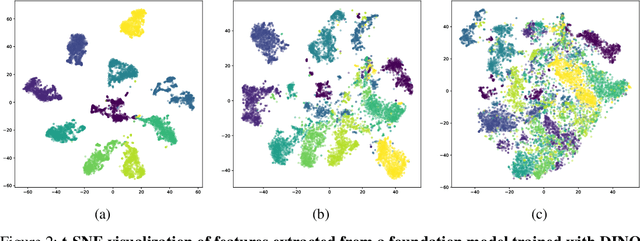
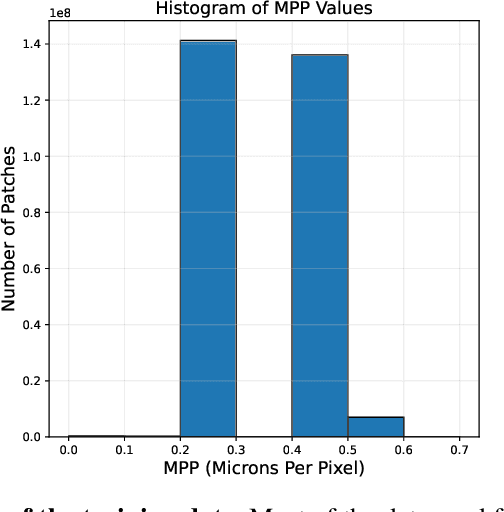
Abstract:Recent advancements in digital pathology have led to the development of numerous foundational models that utilize self-supervised learning on patches extracted from gigapixel whole slide images (WSIs). While this approach leverages vast amounts of unlabeled data, we have discovered a significant issue: features extracted from these self-supervised models tend to cluster by individual WSIs, a phenomenon we term WSI-specific feature collapse. This problem can potentially limit the model's generalization ability and performance on various downstream tasks. To address this issue, we introduce Stain Normalized Pathology Foundational Model, a novel foundational model trained on patches that have undergone stain normalization. Stain normalization helps reduce color variability arising from different laboratories and scanners, enabling the model to learn more consistent features. Stain Normalized Pathology Foundational Model is trained using 285,153,903 patches extracted from a total of 34,795 WSIs, combining data from The Cancer Genome Atlas (TCGA) and the Genotype-Tissue Expression (GTEx) project. Our experiments demonstrate that Stain Normalized Pathology Foundational Model significantly mitigates the feature collapse problem, indicating that the model has learned more generalized features rather than overfitting to individual WSI characteristics. We compared Stain Normalized Pathology Foundational Model with state-of-the-art models across six downstream task datasets, and our results show that Stain Normalized Pathology Foundational Model achieves excellent performance relative to the number of WSIs used and the model's parameter count. This suggests that the application of stain normalization has substantially improved the model's efficiency and generalization capabilities.
 Add to Chrome
Add to Chrome Add to Firefox
Add to Firefox Add to Edge
Add to Edge